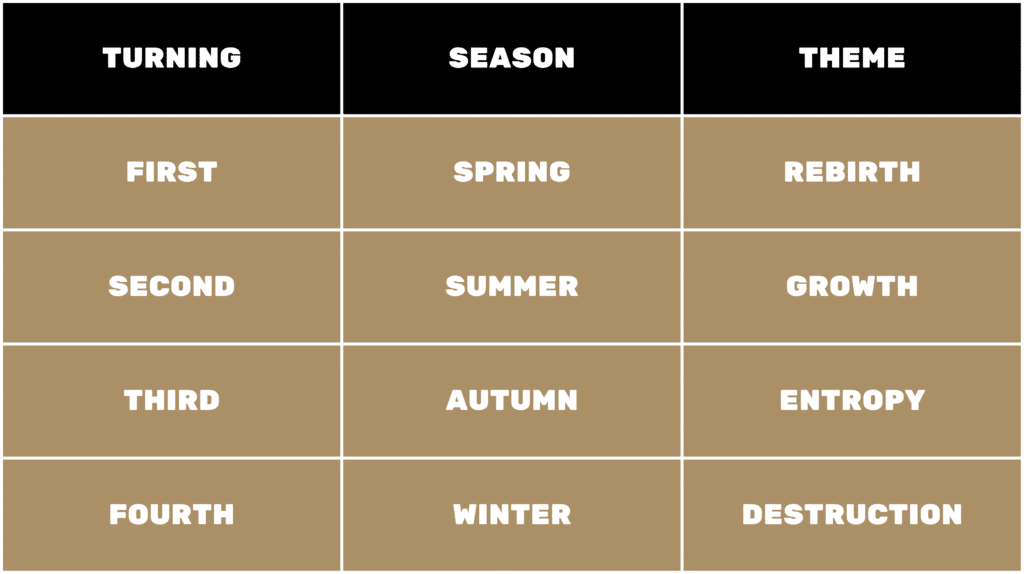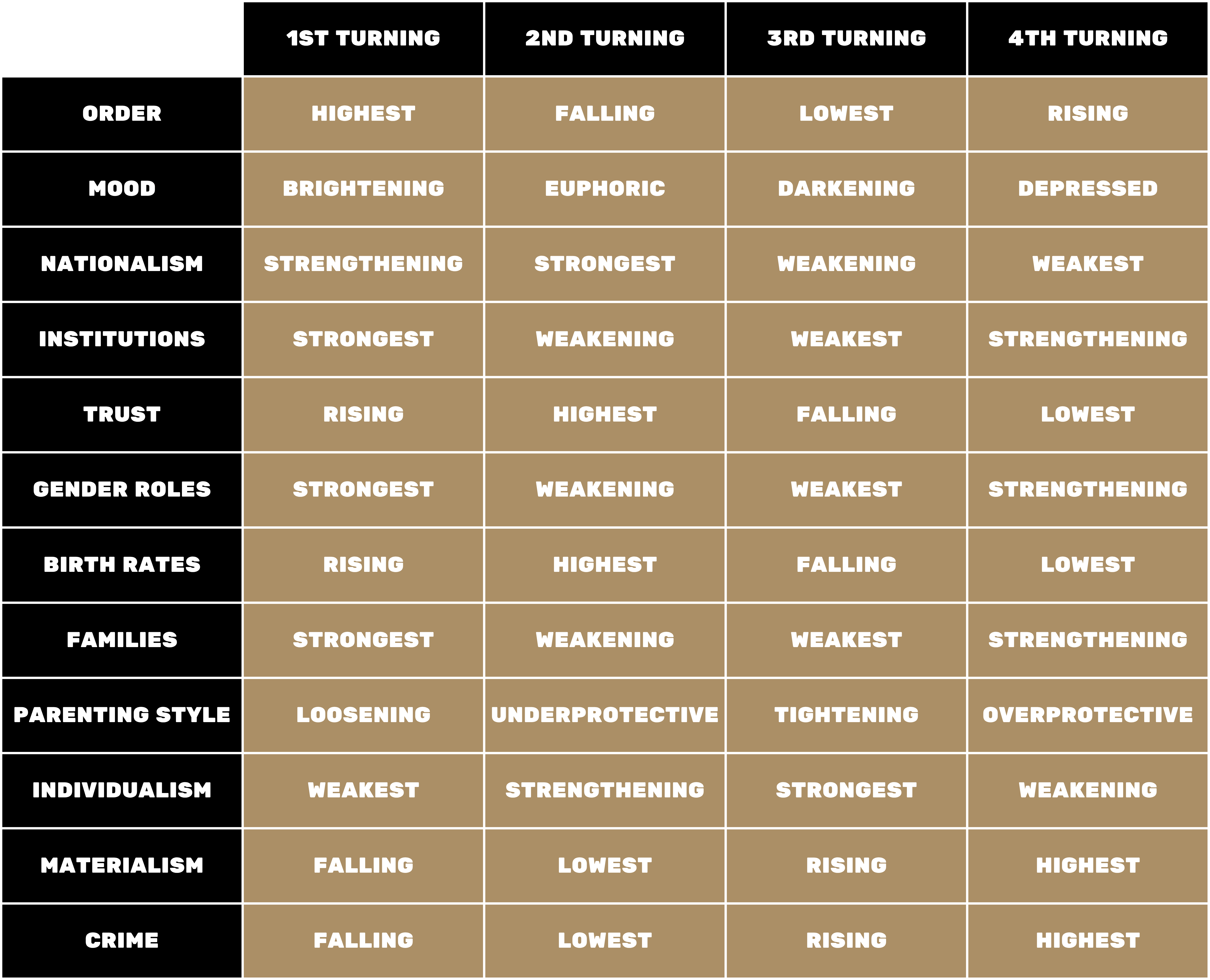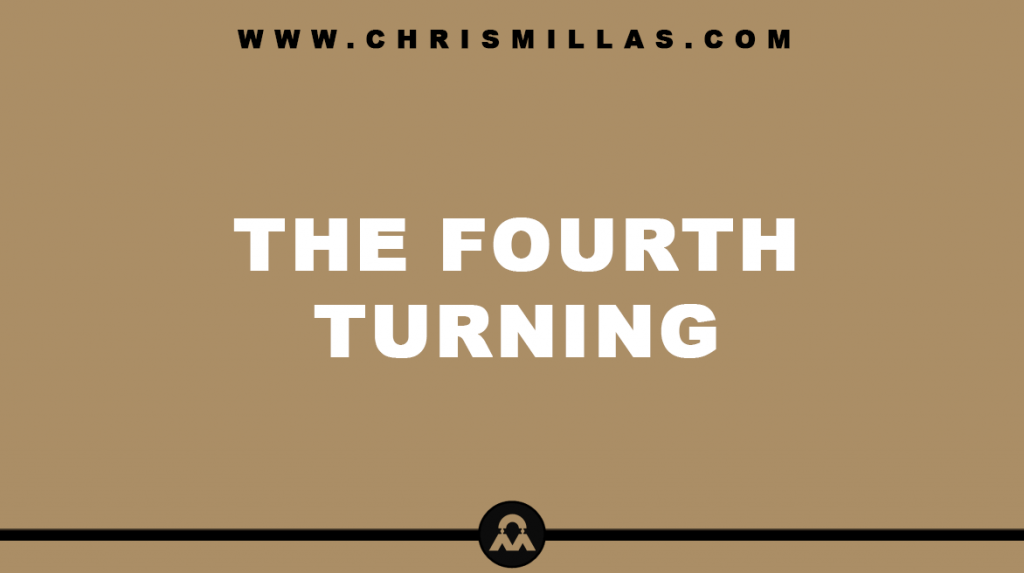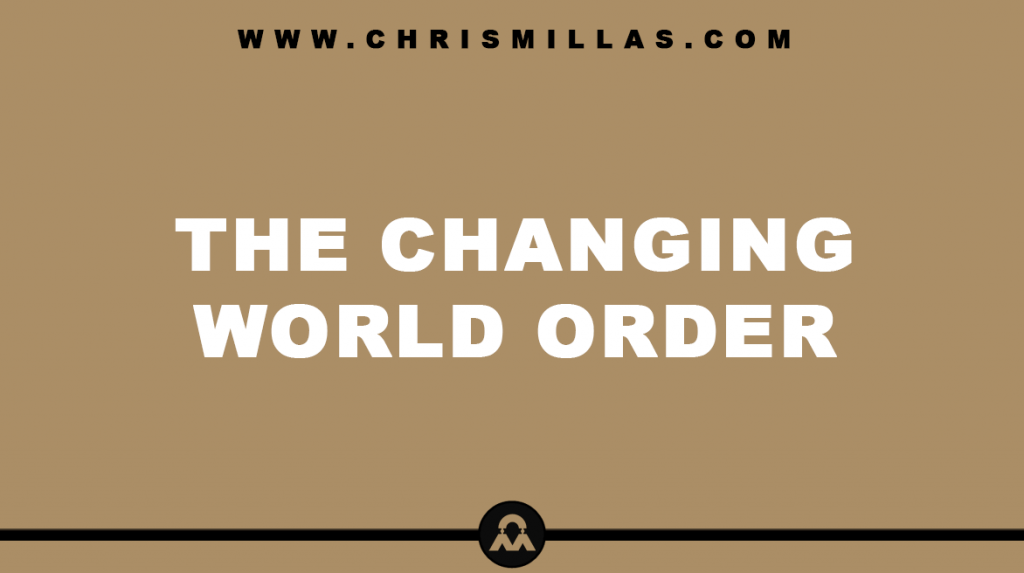In this post, we’ll unpack all you need to know about the book The Fourth Turning, including a breakdown of the core framework, characteristics of each turning, generational archetypes, what to expect in the future and how to position yourself to thrive and more.
What Is The Fourth Turning?
The Fourth Turning is a book by two authors — William Strauss and Neil Howe — that describes how human societies go through clear and predictable cycles.
“History doesn’t repeat itself, but it often rhymes.” ― Mark Twain.
The Fourth Turning Framework
The authors looked back five hundred years and uncover a distinct modern history that moves in cycles.
Each cycle spans the length of a long human life, typically around 80-100 years ― a unit of time that the ancients called the saeculum ― and consists of four Turnings which typically last around 20-25 years.
Each Turning creates a shift in how people feel about themselves, the culture, the nation and the future.
Together, the four Turnings comprise history’s periodic rhythm, in which the seasons of spring, summer, fall, and winter correspond to eras of rebirth, growth, entropy and finally creative destruction. Like the seasons, Turnings can be long or short, they can start early or late, but they cannot be avoided.

“The reward of the historian is to locate patterns that recur over time and to discover the natural rhythms of social experience.” ― William Strauss & Neil Howe
The Four Turnings
The four Turnings that William Strauss and Neil Howe describe are:
- The First Turning | The High ― This is an upbeat era where institutions are at their strongest while individualism is at its weakest. Values converge and society seeks unity (think American High).
- The Second Turning | The Awakening ― This is a passionate era where institutions weaken while individualism strengthens. Values are questioned, leading to cultural revivals (think Consciousness Revolution).
- The Third Turning | The Unravelling ― This is a downbeat era where institutions are at their weakest while individualism is at its strongest. Values diverge and society seeks separation (think World War 1).
- The Fourth Turning | The Crisis ― This is a decisive era where institutions strengthen and individualism weakens. Values are replaced, leading to a new societal order (think World War 2).
After the Fourth Turning comes a new cycle that follows the same pattern.
“The Fourth Turning is for a society what a rite of passage is for an individual. No society ever voluntarily chooses to enter it…yet…no society ever wishes to reverse it once it is complete.” ― Neil Howe
The Four Turnings Table Summary
Below is a table summarising the defining characteristics of each of the four Turnings.

“Just as floods replenish soil and fires rejuvenate forests, a Fourth Turning clears out society’s exhausted elements and creates an opportunity for fresh growth.” ― William Strauss & Neil Howe
Generational Archetypes
The lifecycle of the Four Turnings is made inevitable by the lifecycle of four generational archetypes, their particular order and their general set of characteristics.
Every person belongs to a generation. Every generation belongs to one of four archetypes and has its own common narrative.
The saeculum has four recurring generational archetypes, always in the same order. They are: Prophets, Nomads, Heroes and Artists. Each archetype has a general set of characteristics and endowments which feed into the self-fulfilling nature of the four turnings.
As each generation ages, its persona undergoes profound changes. However, each archetype has an underlying identity that endures. When a generation reaches mid-life and occupies the leadership roles of society, it reflects this orientation on its social environment. This is one of the key reasons why each generation exerts a dominant formative influence on people who are two generations younger ― no two consecutive generations are alike.
The history of humanity can be summarised in 4 sentences. hard times tend to create strong people, strong people tend to create good times, good times tend to create weak people and weak people tend to create hard times.
Throughout their lives, the archetypes can be characterised as follows.
“Your generation isn’t like the generation that shaped you, but it has much in common with the generation that shaped the generation that shaped you. Archetypes do not create archetypes like themselves, instead, they create the shadows of archetypes like themselves.” ― William Strauss & Neil Howe
The Prophet Generation (Most Recent 1946-1964)
A Prophet generation is born during the First Turning.
A Prophet generation tends to grow up as increasingly indulged children during a High, evolve into narcissistic young adults during an Awakening, emerge as moralistic mid-lifers during an Unravelling and age into wise elders during a Crisis.
Principal endowments for the Prophet generation include vision, values and religion.
The Nomad Generation (Most Recent 1964-1984)
A Nomad generation is born during the Second Turning.
A Nomad generation tends to grow up as underprotected children during an Awakening, evolve into alienated young adults during an Unravelling, emerge as pragmatic mid-lifers during a Crisis and age into resilient elders during a High.
Principal endowments for the Nomad generation include liberty, survival and honour.
The Hero Generation (Most Recent 1984-2005)
A Hero generation is born during the Third Turning.
A Hero generation tends to grow up as increasingly protected children during an Unravelling, evolve into teamworkers during a Crisis, emerge as energetic leaders during a High and age into powerful elders during an Awakening.
Principal endowments for the Hero generation include community, affluence and technology.
The Artist Generation (Most Recent 1929-1946)
An Artist generation is born during the Fourth Turning.
An Artist generation tends to grow up as overprotected children during a Crisis, evolve into sensitive young adults during a High, emerge as indecisive leaders during an Awakening and age into empathic elders during an Unravelling.
Principal endowments for the Artist generation include pluralism, expertise and due process.
A Fourth Turning occurs because the Fourth Turning generation have forgotten the lessons of the first.
The Four ArchetypesTable Summary
Below is a table summarising the characteristics of each of the four archetypes.

“The farther backward you can look, the farther forward you can see.” ― Winston Churchill
Where Are We Now?
We are currently deep into a Fourth Turning which was initiated by the financial crisis in 2008. This is evidenced by the global challenges, socio-political upheavals and breakdown of institutions we are experiencing.
Where Are We Going?
If we know that the Fourth Turning began in 2008 and if we know that turnings typically last between 20-25 years, then we can expect this current Fourth Turning to reach its resolution sometime between 2028 and 2033. It could come a little earlier. It could come a little later. But it’s coming.
The resolution to a Fourth Turning is marked by a massive crisis. It could be a social crisis, it could be an economic crisis. or it could be a geopolitical crisis. The point is that it serves as a pivotal moment.
In the meantime, between now and the resolution to the Fourth Turning, we can expect continued chaos and destruction. The paradox is however, that this is necessary For something new to be born, the old needs to die right. Creation requires destruction.
The same way that a fire rejuvenates a forest by destroying the weakest trees which allow the strongest trees to thrive, a Fourth Turning rejuvenates a society by destroying all the weak institutions which allow the strongest institutions to thrive.
So all of the old structures that don’t currently serve society are being destroyed so that new structures that do serve society can be created.
The aftermath of the resolution to the Fourth Turning will then lead us into a First Turning. This will be marked by unity, prosperity and strengthened societal structures – almost like a Golden Age.
“If the current Fourth Turning ends well, America will be able enjoy its next golden age, or at least an era that will feel like a golden age to those who build it.” ― Neil Howe
2020’s Versus 1920’s
What’s interesting is that there are many parallels with the decade of the 1920s – the Roaring Twenties – and the current decade of the 2020s.
The Roaring Twenties was a period that spanned from 1920-1929. It was characterised by major technological innovation, economic growth, speculative investing and social change which created a financial bubble and culminated in the stock market crash of 1929 which ultimately marked the beginning of the Great Depression.
This decade, just like the Roaring Twenties, we’re also experiencing huge tech innovation, economic growth, speculative investments and social change which also looks likely to end in some kind of financial crisis similar to the Great Depression.
Whether we do get another financial crisis again this time round remains to be seen. What’s for sure is that a crisis is coming.
Summary (TL;DR)
The Fourth Turning is defined by four recurring Turnings ― the High, the Awakening, the Unravelling and the Crisis ― and four recurring generational archetypes ― the Prophets, the Nomads, the Heroes and the Artists.
Each cycle typically lasts around 80-100 years and each turning typically lasts around 20-25 years. Each Turning marks a profound shift in how people feel about themselves, the culture, the nation and the future.
Understanding the cyclicality of the four Turnings allows us to not only accept the natural rhythm of human nature. It also empowers us with the knowledge on how to best prepare for and navigate each of the Turnings.


